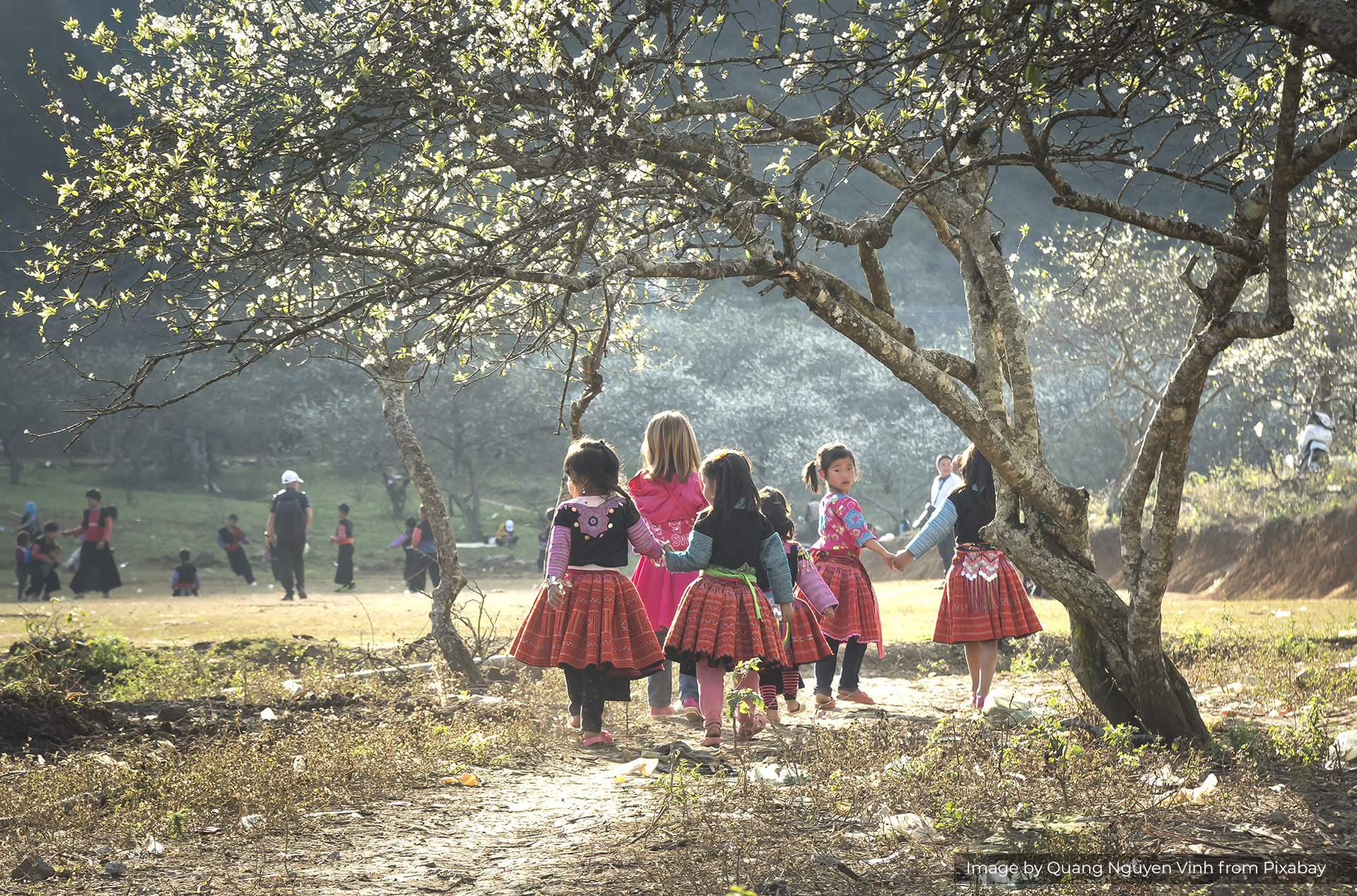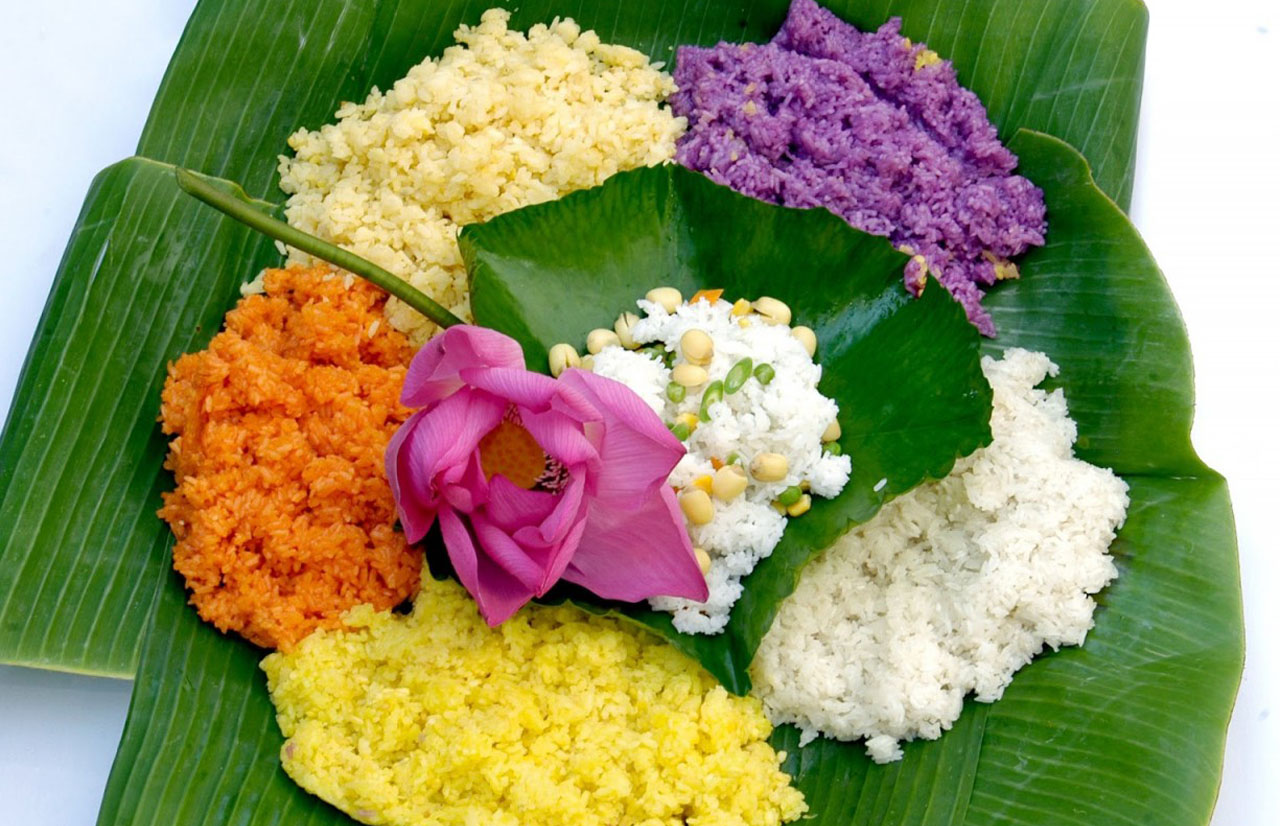
- On 23/07/2023
- In Blogs Travel Tips
- Tags:
Ha Giang, a convergence of natural heritages and unique cultural
Storied by World Travel Awards, UK | awards@worldtravelawards.com. Original sources by Hoang Phong on e.vnexpress.net
Dong Van Stone Plateau is the home to many national relics and landscapes including Lung Cu flag tower, Dong Van ancient town, Ma Pi Leng Pass, and Doi Quan Ba Mountain. All create a beautiful landscape – architecture that invites visitors to explore and enjoy.
Lung Cu Flagpole is another must-see attraction in Ha Giang. It sits in the northernmost position in Vietnam with a 54sqm flag representing 54 ethnic groups of the country. No one can hide the sacred feeling while standing at the foot of the flagpole and singing the national anthem. This is also a great spot for tourists to get a 360-degree view of Ha Giang’s natural beauty.

From here, they will continue their journey with activities imbued with the Lo Lo ethnic group’s cultural identity. They can also visit establishments where people make traditional alcohol, embroidery, and draw beeswax on a linen background.
Hoang Su Phi rice terraces, a National Monument, is a masterpiece created from the hands of hard labour, sweat and brains of the working people. Ha Giang still retains many traditional craft villages. Here, visitors will learn and experience the unique daily life of ethnic minorities through traditional occupations such as linen weaving of the Dao people, brocade of the Tay people, embroidery of the Dao people, La Chi.

The palace consists of six two-storied houses with a total of 64 rooms, all connected to each other. The architecture features the Qing Dynasty style, with green pebbles, pine woods and terra-cotta tiles as the main building materials. Admission fees cost VND 20,000 per person.
The Beauty of Ha Giang
Leaving Dong Van Town, a 25-kilometer road through steep paths and rugged mountains leads to the Lung Cu Flag Tower, which proclaims the nation’s territory and sovereignty, and is mark of pride for all Vietnamese citizens.

Built at the summit of Rong Mountain at the height of 1,700 meters above sea level, the octagonal monument is 33 meters tall and on top of the tower flies a 54-square-meter flag that represents 54 ethnic groups in Vietnam. Visitors have to climb 389 stone steps and another 140 steps on a spiral iron staircase to get to the tower. A panoramic view of Ha Giang awaits those who reach the summit.
The Ma Pi Leng Pass is often described as one of the four most dangerous passes in Vietnam. Soaring over the pass is a mountain 2,000 meters high that is hugged tight by the Hanh Phuc (Happiness) Road connecting Ha Giang Town with the districts of Dong Van and Meo Vac.

The road was completed in 1965 after 11 years of construction mostly by workers belonging to the Hmong ethnic group. Negotiating the pass is a tough task even for the most seasoned travelers and some foreign tourists have died driving off the pass. Currently, some tour operators also offer one-day tours for inexperienced tourists to navigate Ma Pi Leng Pass. Experienced tour guides will take them through the rugged curves and steep cliffs.
Ma Pi Leng is considered one of the top 4 passes in Vietnam which are beautiful but also dangerous to travel. Its name, in Vietnamese meaning (to be more accurate, the name is coined according to H’mong language), means “the bridge of a horse’s nose” that describes the shape of it. Some people compare it to The Great Wall of Vietnam.

A boat trip on the Nho Que River’s turquoise waters at the foot of Ma Pi Leng Pass is another highly recommended travel experience. Hire a motorbike taxi (xe om) to reach the pier and pay VND 120,000 per person for one hour boat trip.

Visitors can also request special photo stops along their way down Tu San, known as one of Southeast Asia’s deepest canyons. There are 23 tourist boats that transport thousands of visitors who come to admire this majestic wonder every year.

Along both sides of the river are rice fields planted by the Giay people. Pho Tro, a small village on the outskirts of Pho Bang Town in Dong Van District, is characterized by traditional ‘trinh tuong’ houses with yin-yang tiled roofs.
As part of a rural renovation program, local authorities have improved infrastructure to develop tourism here. The village now has spacious headquarters and an elementary school. Cemented pathways provide easy access to every house. Households have received subsidies under the program to build bathrooms and indoor toilets.
As noted earlier, visiting Ha Giang from September until November is an opportunity to visit Hoang Su Phi District, famous for 3,000 hectares of terraced rice fields that form wavy, mesmerising golden yellow carpets. There aren’t many places to stay in Hoang Su Phi, but homestays are available in villages or motels in Vinh Quang Town for VND 250,000 to 550,000 ($10 to 23) per night.
It gets cold at nights and early in the morning, so taking a jacket along is a good idea when visiting Hoang Su Phi. Extra care has to be taken when driving on the road from Ha Giang Town to Hoang Su Phi because it’s narrow, winding and crowded with trucks.

Hoàng Su Phì is a rural district of Hà Giang province in the Northeast region of Vietnam. Hoàng Su Phì is famous for its rice field terraces, especially on the road between Hoàng Su Phì and Xín Mần, where those terraces are classified as a National Heritage by the Vietnamese Government.
WHERE TO STAY
Built atop a mountain in Yen Dinh Commune in Bac Me District, the P’apiu Resort is particularly favoured by well-to-do couples who wish to enjoy a peaceful, secluded atmosphere and green landscapes. The resort is also unique in that all its staff are local ethnic minority residents. Room prices start from VND 9.8 million a night.
The Hmong Village resort in Quang Ba District, around 50 kilometers northeast of Ha Giang Town, has 25 bungalows surrounded by green trees and picturesque natural scenery. Bungalows designed in the shape of rattan baskets that Hmong women sling on their backs to carry rice and other things are a distinctive feature of the resort. It also has a community guesthouse that can accommodate up to 40 people at VND400,000 a night. A night’s stay in the bungalows costs from VND 2.4 million ($105.31).

To gaze up on the rice terraced fields during the golden season from their windows, the Hoang Su Phi Lodge and Kinh Homestay in Nam Hong Village are ideal options. Dong Van and Meo Vac districts offer budget-friendly homestays with prices ranging from VND 100,000 to 230,000 per night.
In addition, you can stay at Cho Pua - Auberge de MeoVac (Meo Vac) with a local land house or Dust homestay is a house on stilts in Dong Van. In Dong Van, there is also an ancient house called Hoang Than, which costs 100,000 VND per person; Meo Vac Golden Bee costs only 230,000 VND per night. In Lo Lo Chai village, near the Lung Cu flagpole, there is a homestay Lo Lo Ancient House.

HÀ GIANG CULINARY
Ha Giang has a diverse and unique cuisine. The dishes and drinks are made from raw materials available in nature or cultivated by people. In 2022, Ha Giang has 4 dishes and 4 gift products in the Top 100 dishes and 100 gift products of Vietnam voted by the Vietnam Record Organization.
Given the diversity of ethnic minority communities who live in Ha Giang, a culinary exploration of the province is a rewarding exercise. Xôi Ngũ Sắc (Five-coloured Sticky Rice): red, yellow, blue, purple and white – is made by using fruits, roots and leaves of plants. Glutinous rice is soaked in water for 6-8 hours and divided into five parts. Apart from the original white color, the other parts are dyed with a natural food coloring agent and steamed until tender.
The dish can be found at the weekly flea market in Dong Van Town. From mid-October onwards, the Ha Giang rock plateau blooms with buckwheat flowers, a season which has already made the place a major tourist attraction. Residents use these flowers to make a signature dish – triangle buckwheat cake – that is difficult to find elsewhere.

The buckwheat seeds are harvested, dried and crushed into fine powder. The power is mixed with water to make flat round cakes that are then steamed for about 10 minutes. The cakes bought at the markets can be taken home as a special gift.
Tourists can buy this cake from street food vendors or food stalls in the Dong Van flea market. Thang den is another signature dish made with glutinous rice flour in Ha Giang. It looks like banh troi, the cake with a sweet filling that is popular in Hanoi. The thang den is made by mixing glutinous rice flour with sugar, shaped into balls and steamed. They are served with a syrup made with sweetened coconut milk and ginger. A bowl of thang den is topped with peanuts and/or black sesame seeds.

Though the steamed rice roll, banh cuon, is a popular dish in the north of the country, the version in Ha Giang is quite different. It is filled with pork/egg and mushroom, topped with dried shallots and served with a bowl of delicious bone broth flavored with fresh coriander, chopped scallions and Vietnamese pork sausage. In Ha Giang’s chilly mornings, a bowl of hot broth with banh cuon makes for a great breakfast.

The most popular restaurants to try this dish are: Ms.Ha’s stall at 31 Dong Van Town; and Ms. Cuc’s stall opposite to Ha Giang Town’s social security center. A special porridge favored by the Hmong people in Ha Giang is made of the root of the monkshood aconite plant, known as au tau, which grows on Ha Giang’s highest mountain peak, Tay Con Linh.



Ha Giang has a diverse and unique cuisine
The process of cooking the porridge is very time-consuming, because the roots can be poisonous without being processed and cooked in the right manner. After harvest, the roots are soaked in water for a night and then simmered on a fire for about four hours. They can then be turned into dough and mixed with glutinous rice and pork trotters. The porridge is only sold at night and is served with fried minced pork, pepper, herbs and sour bamboo shoots.
You can find this treat at Ngan Ha Restaurant at 161 Tran Hung Dao Street. The black chicken hotpot is a not-to-be-missed dish on a cold day in Ha Giang. It is normally had with cabbage, peas and other vegetables that make the hotpot sweeter.
Unlike ga ac, a kind of black chicken in the Mekong Delta, the Hmong variety is a rare breed found in the northwestern mountainous provinces of Son La, Lai Chau, Lao Cai and Bac Kan. It is a favorite of the Hmong people, who believe that it helps enhance human vitality, including libido, and is good medicine for heart disease. The hotpot is served at Oanh Hieu Restaurant in Dong Van Town and at Phan’s Restaurant on Hai Ba Trung Street.

Ha Giang is regularly on the list of ideal destinations voted by prestigious travel magazines around the world. The New York Times (USA) has ranked Ha Giang among the most attractive destinations in the world.
Storied by Hoang Phong on e.vnexpress.net and World Travel Awards
Thiên Xuân Travel Service Co., Ltd.
Park 2, 208 Nguyen Huu Canh Street, Ward 22, Bình Thanh District, Ho Chi Minh City, Vietnam
📨 booking@thienxuantravel.com
☎️ +84 888 890 898 — 0938 558 228

